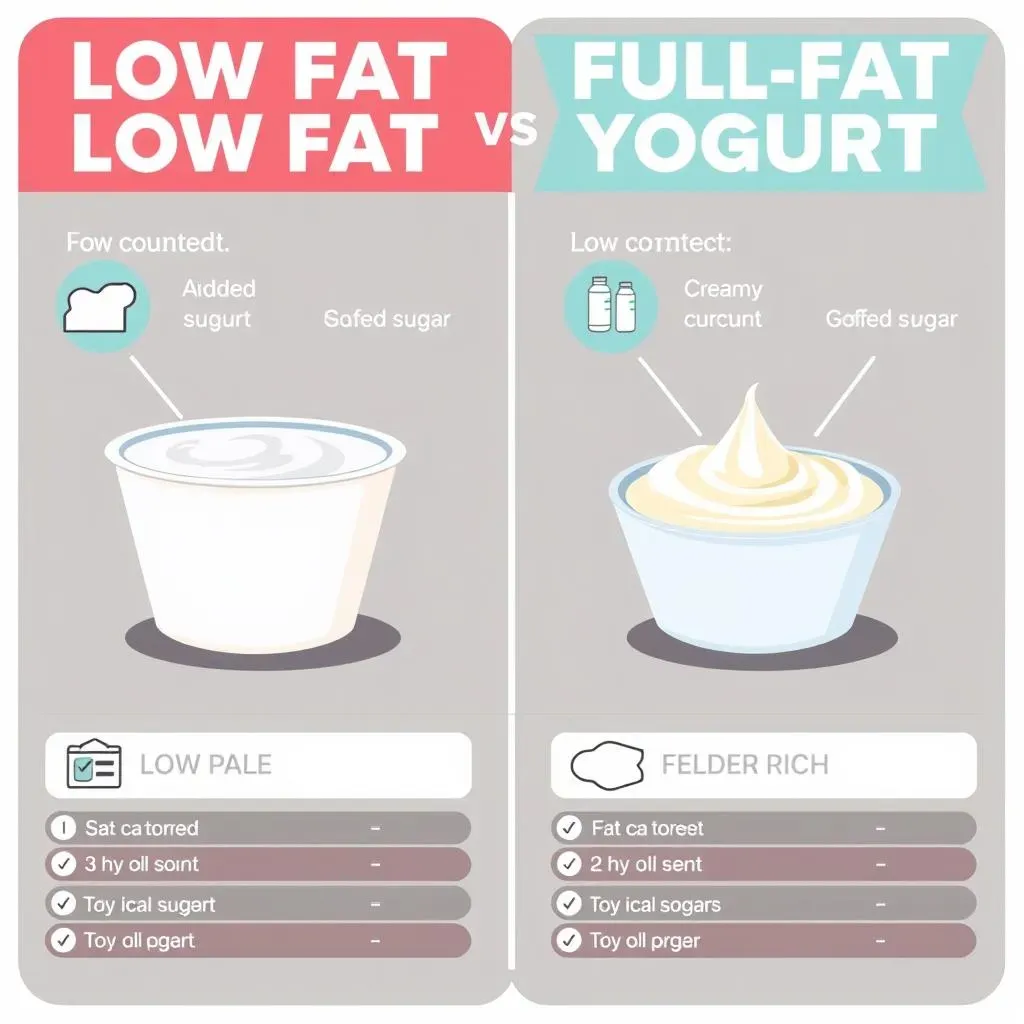Table of Contents
You're standing in the dairy aisle, staring at rows of yogurt. The big question pops up: is yogurt low fat the way to go? It’s a question many of us ponder, especially when trying to make healthier choices. We've all heard the buzz around low-fat options, but does it really mean they're better? This article isn't about blindly following trends; it's about getting real about what's in your yogurt and how it affects you. We'll explore the difference between low-fat and full-fat yogurts, what the science actually says, and help you decide which type is the best fit for your unique needs. We'll look at the health claims, the nutritional differences, and how these choices can impact your diet. So, let’s get the spoon ready and dig into this creamy topic.
LowFat Yogurt: What's the Hype?

LowFat Yogurt: What's the Hype?
Okay, so low-fat yogurt. It's everywhere, right? You see it in the grocery store, plastered on ads, and your aunt keeps talking about how it's the key to her "healthy lifestyle." But let's be real, what's the big deal? It all started when fat got a bad rap. Suddenly, everything low-fat or fat-free was considered the hero of the health world. Yogurt, being a versatile snack, naturally got caught up in this craze. Companies started pushing low-fat versions, promising fewer calories and a slimmer you. It's like they were saying, "Hey, you can have your creamy treat and your skinny jeans too!" But is it that simple? Is the hype around low-fat yogurt actually justified, or are we just buying into a marketing scheme? Let's find out.
The Truth About Fat in Yogurt: LowFat vs. FullFat

The Truth About Fat in Yogurt: LowFat vs. FullFat
Alright, let’s talk fat. It’s not the enemy it's made out to be, especially when it comes to yogurt. When they make low-fat yogurt, they take out the fat, obviously. But here's the kicker: that fat doesn't just disappear. It often gets replaced with something else to make the yogurt taste good, like sugar or artificial sweeteners. So, you might be saving on fat, but you're loading up on other stuff that isn't necessarily better for you. On the other hand, full-fat yogurt keeps all that natural goodness, the fat that can actually keep you feeling full and satisfied. It’s like they are two different worlds, and we need to figure out which one is the right fit for our bodies.
Think of it like this: imagine you're baking a cake. You could use regular butter, or you could try a low-fat substitute. The low-fat option might save you some fat calories, but it can mess with the texture and taste. The same principle applies to yogurt. The fat in full-fat yogurt is what gives it that creamy, rich texture and flavor. When you remove it, you're not just losing fat, you're losing some of the things that make yogurt, well, yogurt. It is a delicate balance, and messing with one aspect can change the whole picture.
Nutrient | Low-Fat Yogurt | Full-Fat Yogurt |
|---|---|---|
Fat | Lower | Higher |
Calories | Often Lower | Often Higher |
Sugar | Often Higher (Added) | May be lower (Natural) |
Protein | Similar | Similar |
Texture | Lighter, Thinner | Creamier, Richer |
Is LowFat Yogurt Healthier? Separating Fact from Fiction

Is LowFat Yogurt Healthier? Separating Fact from Fiction
The Calorie Conundrum
Okay, let's get real about calories. Low-fat yogurt often boasts fewer calories than its full-fat counterpart, and that's true on the surface. But here’s where it gets tricky: not all calories are created equal. When you strip away the fat, you might be left feeling less satisfied, which can lead to reaching for more snacks later. It's like they say, "You get what you pay for", and sometimes, paying less in calories means you are paying in other ways. So, while low-fat yogurt may appear to be the calorie champ, the real story is a bit more complex. We need to look beyond just the numbers and see how it impacts our overall eating habits.
Also, the body needs some fat. It's crucial for hormone production, absorbing vitamins, and keeping you feeling full. When we cut out fat entirely, we might actually be doing our bodies a disservice. It's a delicate balancing act, and it's not as simple as just choosing the lowest calorie option. We need to consider the bigger picture and how our choices affect our overall well-being. It’s about being smart, not just about numbers.
Added Sugar: The Sneaky Culprit
Here’s the real villain in the yogurt aisle: added sugar. To make low-fat yogurt palatable, companies often load it up with sugar, artificial sweeteners, or other flavor enhancers. It's like they take away the fat and replace it with a sugar bomb. This can be a major problem because excessive sugar intake is linked to all sorts of health issues. We are talking weight gain, diabetes, and even heart problems. So, when you think you're making a healthy choice by picking a low-fat option, you might be unknowingly loading up on something much worse. It’s like a wolf in sheep's clothing, where the low-fat label might be hiding a sugary secret.
Now, don’t get me wrong, I'm not saying all low-fat yogurts are evil. Some brands are doing it right by keeping the added sugar to a minimum. But it's up to us to be smart consumers and read those labels carefully. It's like being a detective, looking for clues on the packaging to make the best choice for our bodies. We need to know what's in our food, not just rely on the big "low-fat" label. It’s about being aware and making informed decisions.
Factor | Low-Fat Yogurt | Full-Fat Yogurt |
|---|---|---|
Calorie Density | Lower (Usually) | Higher (Usually) |
Added Sugar | Often Higher | Often Lower |
Satisfaction | Often Lower | Often Higher |
The Real Health Picture
So, what's the bottom line? Is low-fat yogurt the ultimate health food? Well, it depends. If you're choosing a low-fat yogurt that is packed with added sugar, then probably not. But, if you're opting for a plain, low-fat option with minimal added ingredients, then it could be a decent choice if you are trying to cut calories. The truth is, there is no one-size-fits-all answer. It's about balancing the pros and cons and figuring out what works best for your individual needs. It's like finding the right pair of shoes: what works for one person might not work for another.
Ultimately, the decision should be based on your personal health goals, preferences, and what makes you feel good. It's about being mindful of what we put into our bodies and making informed choices. It isn't just about the label on the package; it's about understanding the nutritional content and how it fits into our overall diet. So, next time you are in the yogurt aisle, take a moment to really think about what you're choosing. It’s all about being an informed consumer and making the best choices for yourself.
Making the Right Choice: Is LowFat Yogurt for You?

Making the Right Choice: Is LowFat Yogurt for You?
Finding Your Fit
So, you've made it this far, and you're probably thinking, "Okay, but which yogurt should I actually choose?" Well, it's not about picking a side in the low-fat vs. full-fat debate; it's about finding what works for you. If you're trying to cut down on calories and you're careful about the added sugar, a low-fat yogurt could fit into your diet. But, if you prefer a richer taste, want to feel fuller for longer, and are okay with a little more fat, then full-fat yogurt might be your jam. It's like picking the right pair of jeans – you need to find the ones that fit your body and lifestyle. There's no universal right answer, just what’s right for you.
Think about your personal health goals. Are you trying to lose weight? Maintain your current weight? Or are you just looking for a healthy snack? These factors will play a big role in the type of yogurt you choose. For example, if you’re watching your calorie intake, a low-fat, unsweetened yogurt might be a better fit. But if you find that the low-fat options leave you feeling hungry shortly after, then full-fat might help you stay satisfied for longer, potentially preventing you from overeating later. It’s all about listening to your body and understanding its needs. Don't let the labels dictate your choices, let your body be the judge.
Listen to Your Body
The best approach is to be mindful and pay attention to how your body reacts to different types of yogurt. Do you feel satisfied after eating a low-fat yogurt, or do you find yourself reaching for more food soon after? How does your digestion feel? Do you notice any changes in your energy levels? These are all important clues that can help you make the best choice for you. It's like conducting a little science experiment on yourself, where you are the subject and the scientist. You are the one in charge, so pay attention to all the signals.
Ultimately, the goal is to choose foods that nourish your body and make you feel good. Don't get caught up in the hype or the latest diet trends. Instead, focus on making informed decisions that align with your personal health needs and preferences. Remember, food is meant to be enjoyed, and it should be a source of nourishment, not stress. So, next time you're in the yogurt aisle, take a deep breath, read the labels, and choose the yogurt that makes you and your body happy. It’s about finding the right balance and making choices that support your overall well-being.
Consideration | Low-Fat Yogurt | Full-Fat Yogurt |
|---|---|---|
Calorie Goals | Better if cutting calories, but watch sugar | Better for satiety, if calories are not a concern |
Satiety | May not be as satisfying | Often more satisfying |
Added Sugar | Check label carefully | Often lower in plain varieties |
Personal Preference | If you prefer lighter texture and taste | If you prefer richer texture and taste |
Overall Health | Good option if sugar is low | Good option in moderation |
